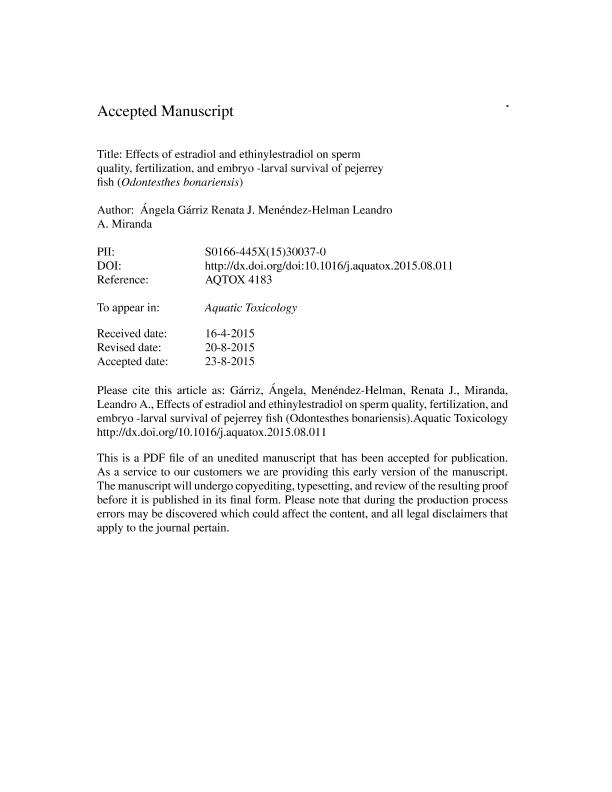Mostrar el registro sencillo del ítem
dc.contributor.author
Garriz, Angela

dc.contributor.author
Menendez Helman, Renata Julia

dc.contributor.author
Miranda, Leandro Andres

dc.date.available
2018-06-15T17:33:10Z
dc.date.issued
2015-10
dc.identifier.citation
Garriz, Angela; Menendez Helman, Renata Julia; Miranda, Leandro Andres; Effects of estradiol and ethinylestradiol on sperm quality, fertilization, and embryo-larval survival of pejerrey fish (Odontesthes bonariensis); Elsevier Science; Aquatic Toxicology; 167; 10-2015; 191-199
dc.identifier.issn
0166-445X
dc.identifier.uri
http://hdl.handle.net/11336/48815
dc.description.abstract
17β-Estradiol (E2) and synthetic 17α-Ethinylestradiol (EE2) are estrogenic compounds present in surface waters as a consequence of municipal sewage discharges. The aim of this study was to evaluate the effects of E2, EE2 and its mixtures on different reproductive parameters and embryo-larval survival in pejerrey fish (Odontesthes bonariensis). In order to analyze the effect of these compounds on sperm quality, fertilization%, embryo-larval survival (%), and the point of no return (PNR), different assays were performed using concentrations 175, 350, 700 and 1400ng/L of E2; 22.5, 45, 90 and 180ng/L of EE2 and mixtures M1 (175 E2+22.5 EE2, ng/L), M2 (350 E2+45 EE2, ng/L), M3 (700 E2+90 EE2, ng/L) and M4 (1400 E2+180 EE2 ng/L). No significant differences in motility parameters were observed between E2 and EE2 treatments and the control group. However, a significant decrease in motility% was recorded for all mixtures tested compared with the control samples. For fertilization%, only sperm activated with M4 showed a significant decrease compared with the control group. In the case of embryo survival, there was only a significant decrease in the highest concentration of EE2 compared with the control group. For the mixtures, M3 is the one that had the most adverse effect on embryo survival. In larval survival, there was a significant decrease in concentration 175 and 700ng/L of E2 compared with the control group. In EE2 treatments, the ones with a significant reduction in larval survival were concentration 45 and 90ng/L. And for the mixture treatments, M1, M3 and M4 had a significantly lower larval survival than the control group. In comparison to other treatments, M1 demonstrated a significant difference in PNR when compared with the control group. The results obtained demonstrated that the exposure to mixtures of E2 and EE2 affected fish sperm motility, fertilization% and, embryo and larval survival even at relevant environmental concentrations highlighting the necessity of considering the effects of pollutants mixtures in ecotoxicological studies.
dc.format
application/pdf
dc.language.iso
eng
dc.publisher
Elsevier Science

dc.rights
info:eu-repo/semantics/openAccess
dc.rights.uri
https://creativecommons.org/licenses/by-nc-nd/2.5/ar/
dc.subject
Embryo And Larval Survival
dc.subject
Estradiol
dc.subject
Ethinylestradiol
dc.subject
Odontesthes Bonariensis
dc.subject
Sperm Quality
dc.subject.classification
Otras Ciencias Biológicas

dc.subject.classification
Ciencias Biológicas

dc.subject.classification
CIENCIAS NATURALES Y EXACTAS

dc.title
Effects of estradiol and ethinylestradiol on sperm quality, fertilization, and embryo-larval survival of pejerrey fish (Odontesthes bonariensis)
dc.type
info:eu-repo/semantics/article
dc.type
info:ar-repo/semantics/artículo
dc.type
info:eu-repo/semantics/publishedVersion
dc.date.updated
2018-06-07T20:04:44Z
dc.identifier.eissn
1879-1514
dc.journal.volume
167
dc.journal.pagination
191-199
dc.journal.pais
Países Bajos

dc.journal.ciudad
Amsterdam
dc.description.fil
Fil: Garriz, Angela. Consejo Nacional de Investigaciones Científicas y Técnicas. Centro Científico Tecnológico Conicet - La Plata. Instituto de Investigaciones Biotecnológicas. Instituto de Investigaciones Biotecnológicas "Dr. Raúl Alfonsín" (sede Chascomús). Universidad Nacional de San Martín. Instituto de Investigaciones Biotecnológicas. Instituto de Investigaciones Biotecnológicas "Dr. Raúl Alfonsín" (sede Chascomús); Argentina
dc.description.fil
Fil: Menendez Helman, Renata Julia. Consejo Nacional de Investigaciones Científicas y Técnicas. Centro Científico Tecnológico Conicet - La Plata. Instituto de Investigaciones Biotecnológicas. Instituto de Investigaciones Biotecnológicas "Dr. Raúl Alfonsín" (sede Chascomús). Universidad Nacional de San Martín. Instituto de Investigaciones Biotecnológicas. Instituto de Investigaciones Biotecnológicas "Dr. Raúl Alfonsín" (sede Chascomús); Argentina. Universidad de Buenos Aires. Facultad de Ciencias Exactas y Naturales. Departamento de Química Biológica. Laboratorio de Enzimología, Estrés Oxidativo y Metabolismo; Argentina
dc.description.fil
Fil: Miranda, Leandro Andres. Consejo Nacional de Investigaciones Científicas y Técnicas. Centro Científico Tecnológico Conicet - La Plata. Instituto de Investigaciones Biotecnológicas. Instituto de Investigaciones Biotecnológicas "Dr. Raúl Alfonsín" (sede Chascomús). Universidad Nacional de San Martín. Instituto de Investigaciones Biotecnológicas. Instituto de Investigaciones Biotecnológicas "Dr. Raúl Alfonsín" (sede Chascomús); Argentina
dc.journal.title
Aquatic Toxicology

dc.relation.alternativeid
info:eu-repo/semantics/altIdentifier/doi/http://dx.doi.org/10.1016/j.aquatox.2015.08.011
dc.relation.alternativeid
info:eu-repo/semantics/altIdentifier/url/https://www.sciencedirect.com/science/article/pii/S0166445X15300370
Archivos asociados
